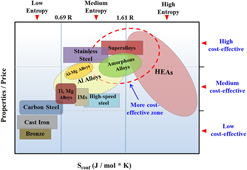Crossref Citations
This article has been cited by the following publications. This list is generated based on data provided by
Crossref.
Zhang, Yong
2019.
High-Entropy Materials.
p.
129.
Beyramali Kivy, Mohsen
Hong, Yu
and
Asle Zaeem, Mohsen
2019.
A Review of Multi-Scale Computational Modeling Tools for Predicting Structures and Properties of Multi-Principal Element Alloys.
Metals,
Vol. 9,
Issue. 2,
p.
254.
Sarswat, Prashant K.
Sarkar, Sayan
Murali, Arun
Huang, Wenkang
Tan, Wenda
and
Free, Michael L.
2019.
Additive manufactured new hybrid high entropy alloys derived from the AlCoFeNiSmTiVZr system.
Applied Surface Science,
Vol. 476,
Issue. ,
p.
242.
Zhang, Yong
2019.
High-Entropy Materials.
p.
77.
Li, Song
Li, Yijie
Xiao, Na
Fang, Beichang
and
Qin, Gaowu
2019.
Screening alloy electrocatalysts by combining magnetron sputtering and scanning electrochemical microscopy.
Philosophical Magazine Letters,
Vol. 99,
Issue. 5,
p.
185.
Yan, Xue-Hui
Ma, Jiang
and
Zhang, Yong
2019.
High-throughput screening for biomedical applications in a Ti-Zr-Nb alloy system through masking co-sputtering.
Science China Physics, Mechanics & Astronomy,
Vol. 62,
Issue. 9,
Zhao, Sha
He, Lin-xin
Fan, Xiao-xia
Liu, Chun-hai
Long, Jian-ping
Wang, Long
Chang, Hong
Wang, Jian
and
Zhang, Wei
2019.
Microstructure and chloride corrosion property of nanocrystalline AlTiCrNiTa high entropy alloy coating on X80 pipeline steel.
Surface and Coatings Technology,
Vol. 375,
Issue. ,
p.
215.
Yan, Xuehui
and
Zhang, Yong
2020.
Functional properties and promising applications of high entropy alloys.
Scripta Materialia,
Vol. 187,
Issue. ,
p.
188.
Guo, Y.
Liu, L.
Zhang, W.
Yao, K.D.
Chen, W.
Ren, J.
Qi, J.G.
Wang, B.
Zhao, Z.F.
Shang, J.
Zhang, Y.
and
Xiang, J.
2020.
A new method for preparing high entropy alloys: Electromagnetic pulse treatment and its effects on mechanical and corrosion properties.
Materials Science and Engineering: A,
Vol. 774,
Issue. ,
p.
138916.
Sarswat, Prashant
Smith, Taylor
Sarkar, Sayan
Murali, Arun
and
Free, Michael
2020.
Design and Fabrication of New High Entropy Alloys for Evaluating Titanium Replacements in Additive Manufacturing.
Materials,
Vol. 13,
Issue. 13,
p.
3001.
Zhang, Lu
and
Zhang, Yong
2020.
Tensile Properties and Impact Toughness of AlCoxCrFeNi3.1–x (x = 0.4, 1) High-Entropy Alloys.
Frontiers in Materials,
Vol. 7,
Issue. ,
Wu, Yaqi
Liaw, Peter
and
Zhang, Yong
2021.
Preparation of Bulk TiZrNbMoV and NbTiAlTaV High-Entropy Alloys by Powder Sintering.
Metals,
Vol. 11,
Issue. 11,
p.
1748.
Chaudhary, Varun
Chaudhary, Richa
Banerjee, Rajarshi
and
Ramanujan, R.V.
2021.
Accelerated and conventional development of magnetic high entropy alloys.
Materials Today,
Vol. 49,
Issue. ,
p.
231.
Zhu, Bo
Alavi, Sina
Cheng, Changjun
Sun, Haokun
Zhao, Hongwei
Kim, Keun Su
Mostaghimi, Javad
and
Zou, Yu
2021.
Fast and High‐Throughput Synthesis of Medium‐ and High‐Entropy Alloys Using Radio Frequency Inductively Coupled Plasma.
Advanced Engineering Materials,
Vol. 23,
Issue. 3,
Zhao, Yakai
Lau, Kwang Boon
Teh, Wei Hock
Lee, Jing Jun
Wei, Fengxia
Lin, Ming
Wang, Pei
Tan, Cheng Cheh
and
Ramamurty, Upadrasta
2021.
Compositionally graded CoCrFeNiTi high-entropy alloys manufactured by laser powder bed fusion: A combinatorial assessment.
Journal of Alloys and Compounds,
Vol. 883,
Issue. ,
p.
160825.
Fu, Yu
Li, Jun
Luo, Hong
Du, Cuiwei
and
Li, Xiaogang
2021.
Recent advances on environmental corrosion behavior and mechanism of high-entropy alloys.
Journal of Materials Science & Technology,
Vol. 80,
Issue. ,
p.
217.
Goodelman, Daniel C.
White, Danielle E.
and
Hodge, Andrea M.
2021.
Phase transition zones in compositionally complex alloy films influenced by varying Al and Ti content.
Surface and Coatings Technology,
Vol. 424,
Issue. ,
p.
127651.
Li, Yasong
Zhou, Shichao
and
Zhang, Yong
2021.
High-Entropy Materials: Theory, Experiments, and Applications.
p.
721.
Li, Rongbin
Huang, Tian
Zhang, Jing
Jiang, Chunxia
Zhang, Yong
and
Liaw, Peter
2022.
Microstructures, Mechanical Behavior, and Radiation Damage of (TiVCr)x-(TaW)1-x Binary System High-Entropy Alloy Films.
Metals,
Vol. 12,
Issue. 5,
p.
772.
Wang, Qiannan
Yang, Hongwang
Zuo, Xiaojiao
Wang, Yinxiao
and
Yao, Jiahao
2022.
High-Throughput Preparation and Characterization of ZrMoTaW Refractory Multi-Principal Element Alloy Film.
Materials,
Vol. 15,
Issue. 23,
p.
8546.



